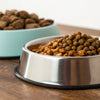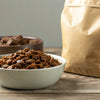How Much Should I Feed My Dog Dry Food? A Comprehensive Guide for Pet Owners
- Houndsy
Table of Contents
- Introduction
- Understanding Your Dog's Nutritional Needs
- Recommended Feeding Guidelines
- The Importance of Proper Portion Control
- Feeding Schedules: How Often Should You Feed Your Dog?
- The Role of Quality Dog Food
- Consulting Your Veterinarian
- Conclusion
Introduction
Did you know that approximately 59% of dogs in the United States are overweight or obese? This staggering statistic highlights a critical aspect of dog ownership: feeding our furry friends the right amount of food is vital for their health and well-being. As pet owners, we often find ourselves grappling with the question: "How much should I feed my dog dry food?" Understanding the right portion sizes for our dogs is essential, yet it can be a complicated issue influenced by various factors such as age, size, activity level, and even breed.
In this blog post, we aim to demystify the process of determining how much dry food to feed your dog. By the end, we hope you will have a better understanding of the guidelines and best practices to ensure your furry companion remains happy and healthy. We will cover the factors affecting your dog’s dietary needs, the importance of proper portion control, and specific feeding recommendations tailored to different life stages.
Let’s embark on this journey to elevate the everyday experience of feeding our beloved pets, ensuring they receive the nourishment they need to thrive.
Understanding Your Dog's Nutritional Needs
When considering how much to feed your dog, it’s essential to recognize that there is no one-size-fits-all answer. Each dog has unique dietary requirements based on various factors:
1. Age
Puppies have different nutritional needs compared to adult dogs and senior dogs. Puppies require a higher caloric intake, rich in proteins and nutrients, to support their rapid growth and development. In general, they need to be fed more frequently than adults, often three to four times a day.
Conversely, senior dogs (usually those over 7 years old) may require fewer calories and less frequent feeding due to decreased energy levels and metabolism. Their dietary needs can further shift based on health conditions common in older age, such as arthritis or heart disease.
2. Size and Breed
The size of your dog significantly impacts how much food they should receive. Larger breeds typically require more food than smaller breeds. For example, a Great Dane will have a vastly different caloric requirement compared to a Chihuahua. Moreover, certain breeds have higher metabolisms and energy levels, which can necessitate more food.
3. Activity Level
A dog’s activity level is a crucial determinant of their caloric needs. Active dogs, such as working or sporting breeds, require more calories to fuel their energy expenditure. On the flip side, less active dogs may need fewer calories to avoid weight gain.
4. Body Condition Score (BCS)
Your dog’s body condition score is an important tool to evaluate their weight and overall health. It provides a visual guide to determine whether a dog is underweight, at a healthy weight, or overweight. Adjusting your dog’s food intake based on their BCS can help you maintain their ideal weight.
5. Health Status
Chronic health issues can necessitate dietary adjustments. Dogs with conditions like diabetes, kidney disease, or allergies may require specialized diets or specific caloric intakes. Always consult with a veterinarian if your dog has any health issues that may affect their diet.
Recommended Feeding Guidelines
To determine how much dry food to feed your dog, start by looking at the feeding guidelines provided on the packaging of the dog food you use. These guidelines typically offer a daily feeding amount based on your dog’s weight and can serve as a helpful starting point.
Example Feeding Guide
Here’s a general feeding guide based on dog weight:
- Small Dogs (up to 20 lbs): ½ to 1 cup per day
- Medium Dogs (21-50 lbs): 1 to 2 cups per day
- Large Dogs (51-100 lbs): 2 to 4 cups per day
- Giant Dogs (over 100 lbs): 4 to 6 cups per day
These amounts should be divided into two meals per day for adults, while puppies may require three to four meals daily.
Monitoring and Adjusting Portions
After following the initial recommendations, observe your dog’s body condition. If they appear to be gaining or losing weight, you may need to adjust their portion sizes accordingly.
Treats and Extras
Don’t forget to account for treats in your dog’s daily caloric intake. Treats should make up no more than 10% of your dog’s total daily calories to ensure they do not contribute to excessive weight gain.
The Importance of Proper Portion Control
Feeding your dog the correct amount of food is crucial for preventing health issues associated with both underfeeding and overfeeding.
Consequences of Overfeeding
- Obesity: Overweight dogs are at a higher risk for serious health problems, including joint disease, heart issues, and diabetes.
- Gastrointestinal Distress: Excessive food can cause digestive problems like bloating or vomiting.
- Reduced Quality of Life: An overweight dog may have less energy and struggle with mobility.
Consequences of Underfeeding
- Nutritional Deficiencies: Feeding too little can lead to inadequate nutrient intake, impacting your dog’s coat, skin, and overall health.
- Low Energy Levels: An underfed dog may exhibit low energy, lethargy, and a lack of enthusiasm.
- Increased Risk of Illness: A weakened immune system from poor nutrition can make dogs more susceptible to illnesses.
Feeding Schedules: How Often Should You Feed Your Dog?
Feeding frequency is another essential aspect of dog nutrition. Most adult dogs thrive on a routine of two meals per day, while puppies may require more frequent feedings.
General Recommendations for Feeding Frequency
- Puppies (up to 4 months): 3-4 meals per day
- Puppies (4-12 months): 2-3 meals per day
- Adult Dogs: 2 meals per day
- Senior Dogs: 1-2 meals per day, depending on activity and health status
Establishing a consistent feeding routine can help regulate digestion and prevent hunger-related behaviors.
The Role of Quality Dog Food
Not all dog food is created equal. The quality of the food you choose can affect how much you should feed your dog. High-quality, nutrient-dense food may require smaller portions than lower-quality options filled with fillers.
Choosing the Right Dog Food
When selecting dog food, consider the following:
- Nutritional Value: Look for foods that meet AAFCO standards and provide balanced nutrition.
- Ingredients: Choose foods made with high-quality, whole ingredients, avoiding artificial additives and fillers.
- Life Stage: Select food formulated for your dog’s specific life stage (puppy, adult, or senior) to support their unique nutritional needs.
At Houndsy, we believe in enhancing the dog-feeding experience through innovative design and quality products. Our flagship Houndsy Kibble Dispenser not only provides perfect portions every time but also keeps your dog’s food fresh with a BPA-free liner and large storage capacity.
Explore our Houndsy Kibble Dispenser here to elevate your dog feeding routine.
Consulting Your Veterinarian
While general guidelines can provide a framework, it’s always best to consult with your veterinarian for personalized feeding recommendations. They can help assess your dog’s individual needs and make informed suggestions based on their age, size, health status, and lifestyle.
Conclusion
Feeding your dog the right amount of dry food is an integral part of responsible pet ownership. By understanding the factors that influence their dietary needs, monitoring their body condition, and adjusting portions accordingly, we can ensure our furry friends lead healthy, happy lives.
As we have discussed, feeding guidelines, portion control, and food quality all play vital roles in maintaining our dogs' health. Remember to establish a consistent routine, consider your dog's unique needs, and don’t hesitate to reach out to your veterinarian for guidance.
Are you ready to enhance your feeding experience? Check out the Houndsy Kibble Dispenser to simplify your dog feeding routine while keeping it stylish and functional.
FAQ
Q: How much dry food should I feed my dog?
A: The amount varies based on your dog’s weight, age, size, and activity level. Refer to the feeding guidelines on your dog food packaging for a starting point.
Q: How often should I feed my dog?
A: Most adult dogs do well with two meals per day, while puppies may need three to four meals a day.
Q: Can I feed my dog treats?
A: Yes, but treats should not exceed 10% of your dog’s total daily caloric intake.
Q: What should I do if my dog is overweight?
A: Consult your veterinarian to determine the best course of action, which may include adjusting their food intake and incorporating more exercise.
Q: Is it safe to free-feed my dog?
A: Free-feeding is generally not recommended as it can lead to overeating and obesity in many dogs. It’s better to establish a regular feeding schedule.












